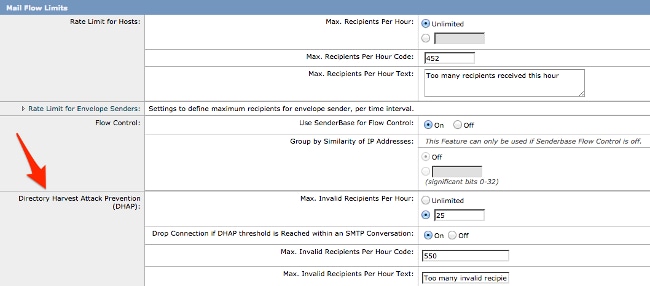Localizar la información de alerta DHAP en el ESA
Contenido
Introducción
En este documento se describe cómo localizar información relacionada con las alertas de prevención de ataques de recolección de directorios (DHAP) en su dispositivo de seguridad Cisco Email Security Appliance (ESA).
Localizar las apariciones de DHAP desde el ESA
Las entradas que describen el evento DHAP residen en los registros de correo. Aquí hay un ejemplo de entrada del registro de correo cuando ocurre DHAP:
Tue Oct 18 00:25:35 2005 Warning: LDAP: Dropping connection due to potential Directory
Harvest Attack from host=(192.168.10.1', None), dhap_limit=4, sender_group=SUSPECTLIST
Ingrese esta consulta en la CLI para ver los registros de correo:
myesa.local> grep "dhap_limit=" mail_logs
Los contadores DHAP incluyen rechazos de tabla de acceso de destinatarios (RAT) y de consulta de aceptación del protocolo ligero de acceso a directorios (LDAP). Los parámetros de DHAP se configuran en la política de flujo de correo.
Ver o actualizar la configuración DHAP desde la GUI
Complete estos pasos para ver o editar sus parámetros de configuración DHAP desde la GUI:
- Vaya a Políticas de correo > Políticas de flujo de correo.
- Haga clic en el nombre de la política para hacer ediciones, o haga clic en Parámetros de Política Predeterminados para ver la configuración DHAP actual.
- Realice los cambios necesarios en la sección Prevención de ataques de recolección de directorios (DHAP):

- Haga clic en Submit, y luego haga clic en Commit para guardar los cambios.
Ver o actualizar la configuración DHAP desde la CLI
Para ver o editar sus parámetros de configuración DHAP desde la CLI, ingrese el comando listenerconfig > edit [listener number] > hostaccess > default:
Default Policy Parameters
==========================
Maximum Message Size: 10M
Maximum Number Of Concurrent Connections From A Single IP: 10
Maximum Number Of Messages Per Connection: 10
Maximum Number Of Recipients Per Message: 50
Directory Harvest Attack Prevention: Enabled
Maximum Number Of Invalid Recipients Per Hour: 25
Maximum Number Of Recipients Per Hour: Disabled
Maximum Number of Recipients per Envelope Sender: Disabled
Use SenderBase for Flow Control: Yes
Spam Detection Enabled: Yes
Virus Detection Enabled: Yes
Allow TLS Connections: No
Allow SMTP Authentication: No
Require TLS To Offer SMTP authentication: No
DKIM/DomainKeys Signing Enabled: No
DKIM Verification Enabled: No
SPF/SIDF Verification Enabled: No
DMARC Verification Enabled: No
Envelope Sender DNS Verification Enabled: No
Domain Exception Table Enabled: No
Accept untagged bounces: No
There are currently 5 policies defined.
There are currently 8 sender groups.
Choose the operation you want to perform:
- NEW - Create a new entry.
- EDIT - Modify an entry.
- DELETE - Remove an entry.
- MOVE - Move an entry.
- DEFAULT - Set the defaults.
- PRINT - Display the table.
- IMPORT - Import a table from a file.
- EXPORT - Export the table to a file.
- RESET - Remove senders and set policies to system default.
[]> default
Enter the default maximum message size. Add a trailing k for kilobytes, M for
megabytes, or no letter for bytes.
[10M]>
Enter the maximum number of concurrent connections allowed from a single IP address.
[10]>
Enter the maximum number of messages per connection.
[10]>
Enter the maximum number of recipients per message.
[50]>
Do you want to override the hostname in the SMTP banner? [N]>
Would you like to specify a custom SMTP acceptance response? [N]>
Would you like to specify a custom SMTP rejection response? [N]>
Do you want to enable rate limiting per host? [N]>
Do you want to enable rate limiting per envelope sender? [N]>
Do you want to enable Directory Harvest Attack Prevention per host? [Y]>
Enter the maximum number of invalid recipients per hour from a remote host.
[25]>
Select an action to apply when a recipient is rejected due to DHAP:
1. Drop
2. Code
[1]>
Would you like to specify a custom SMTP DHAP response? [Y]>
Enter the SMTP code to use in the response. 550 is the standard code.
[550]>
Enter your custom SMTP response. Press Enter on a blank line to finish.
Would you like to use SenderBase for flow control by default? [Y]>
Would you like to enable anti-spam scanning? [Y]>
Would you like to enable anti-virus scanning? [Y]>
Do you want to allow encrypted TLS connections?
1. No
2. Preferred
3. Required
4. Preferred - Verify
5. Required - Verify
[1]>
Would you like to enable DKIM/DomainKeys signing? [N]>
Would you like to enable DKIM verification? [N]>
Would you like to change SPF/SIDF settings? [N]>
Would you like to enable DMARC verification? [N]>
Would you like to enable envelope sender verification? [N]>
Would you like to enable use of the domain exception table? [N]>
Do you wish to accept untagged bounces? [N]>
Si decide realizar actualizaciones, asegúrese de volver al indicador principal de CLI y confirmar todos los cambios.
Información Relacionada
Historial de revisiones
| Revisión | Fecha de publicación | Comentarios |
|---|---|---|
1.0 |
23-Apr-2015
|
Versión inicial |
Contacte a Cisco
- Abrir un caso de soporte

- (Requiere un Cisco Service Contract)
 Comentarios
Comentarios